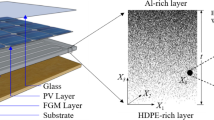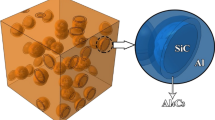Abstract
Functionally graded materials (FGMs) can be fabricated using the centrifugal method, and the nanoparticle distribution in the matrix affects the FGM properties such as heat resistance. In this study, we developed a multiphysics simulation using the kinetic Monte Carlo (KMC) simulation and finite element method (FEM) to investigate the fabrication process of FGM and the resulting material properties, respectively. In the KMC simulation, we modeled the agglomeration and gravitational sedimentation of nanoparticles during the centrifugal fabrication process; thus, we determined the nanoparticle distribution in the FGM. The fabricated FGM nanostructure depended on the Peclet number, which was defined based on the rate ratio of solvent evaporation and nanoparticle diffusion. Thereafter, we performed FEM analysis to examine the heat resistance property of FGM, in which 2D quad mesh was adapted to express fine nanoparticles. We determined the thermal conductivity of FGM by assuming copper nanoparticles and epoxy resin as constituents. The thermal conductivity of FGM depended mainly on the Peclet number; the gravity had little influence. In addition, we found that the FGMs consisting of elliptical nanoparticles exhibited higher thermal conductivities than those consisting of circular nanoparticles. The presented simulation could be useful in examining fabrication conditions to achieve the improvement of heat-resistant FGMs using nanoparticles.
Graphical Abstract











Similar content being viewed by others
References
Bhavar V, Kattire P, Thakare S, Patil S, Singh R (2017) A review on functionally gradient materials (FGMs) and their applications. IOP Conf Series Mat Sci Eng 229:012021-1–012021-9
Larkin K, Hunter A, Abdelkefi A (2020) Size-dependent modeling and performance enhancement of functionally graded piezoelectric energy harvesters. J Nanopart Res 22:225
Saleh B, Jiang J, Fathi R, Hababi AT, Xu Q, Wang L, Song D, Ma A (2020) 30 Years of functionally graded materials: an overview of manufacturing methods, Applications and Future Challenges. Composite Part B 201:108376
Noda N, Nakai S, Tsuji T (1998) Thermal stress in functionally graded material of particle-reinforced composite. JSME Int J Series A 41(2):178–184
Gantayat AK, Sutar MK, Mohanty JR (2022) Dynamic characteristic of graphene reinforced axial functionally graded beam using finite element analysis. Mat Today Proc 62:5923–5927
Ma Y, Liu M, Xie B, Han W, Yu H, Huang S, Chai X, Liu Y, Zhang Z (2021) Neutronic and thermal-mechanical coupling analyses in a solid-state reactor using Monte Carlo and finite element methods. Ann Nucl Energy 151:107923
Ganao FY, Kim J, Zur KK (2021) Nonlinear finite element analysis of temperature-dependent functionally graded porous micro-plates under thermal and mechanical loads. Comp Struct 256:112931
Kasaeian AB, Vatan NSH, Daneshmand S (2011) FGM materials and finding an appropriate model for the thermal conductivity. Procedia Eng 14:3199–3204
Yaghoobi MP, Ghannad M (2020) An analytical solution for heat conduction of FGM cylinders with varying thickness subjected to non-uniform heat flux using a first-order temperature theory and perturbation technique. Int Commun Heat Mass Transf 116:104684
Ogawa T, Watanabe Y, Sato H, Kim IS, Fukui Y (2006) Theoretical study on fabrication of functionally graded material with density gradient by a centrifugal solid-particle method. Composites Part A: App Sci Manuf 37:2194–2200
Gao JW, Wang CY (2000) Modeling the solidification of functionally graded materials by centrifugal casting. Mat Sci Eng A292:207–215
Watanabe Y, Sato H (2010) Novel fabrication method of FGM containing nano-particles – centrifugal mixed-power method. Key Eng Mat 434-435:751–756
Mishra SK, Shukla DK, Patel RK (2018) Flexural properties of functionally graded epoxy-alumina polymer nanocomposite. Material Today Proc 5:8431–8435
Zhang B, Fan B, Huang Z, Higa K, Battaglia VS, Prassher RS (2023) A review of dispersion film drying research. J Electrochem Eng Conv Stor 20:030801
Bhaskar S, Das P, Srinivasan V, Bhaktha BNS, Ramamurthy SS (2022) Plasmonic-silver sorets and dielectric-Nd2O3 nanorods for ultrasensitive photonic crystal-coupled emission. Mater Res Bull 145:111558
Rai A, Bhaskar S, Ganesh KM, Ramamurthy SS (2022) Hottest hotspots from the coldest cold: welcome to Nano 4.0. ACS Appl Nano Mater 5:12245–12264
Lee K, Choi SQ (2020) Stratification of polymer–colloid mixtures via fast nonequilibrium evaporation. Soft Matter 16:10326
Burdette-Trofimov MK, Armstrong BL, Nelson WJ, Rogers AM, Yang G, Self EC, Armstrong RR, Nanda J, Veith GM (2020) Direct measure of electrode spatial heterogeneity: influence of processing conditions on anode architecture and performance. ACS Appl Mater Interfaces 12:55954–55970
Mazur LO, Bulavin LA, Vygornitskii NV, Lebovka NI (2019) Effects of Brownian motions on electrical conductivity and optical transparency of two-dimensional films Filled by Needle-Like Particles. Ukr J Phys 64:4-354–359
Chiappini M, Grelet E, Dijkstra M (2020) Speeding up dynamics by tuning the noncommensurate size of rodlike particles in a smectic phase. Phys Rev Lett 124:087801-1–087801-6
Kameya Y (2017) Kinetic Monte Carlo simulation of nanoparticle film formation via nanocolloid drying. J Nanopart Res 19:214
Cardinal CM, Jung YD, Ahn KH, Francis LF (2010) Drying regime maps for particulate coatings. AIChE J 56:2769–2780
Rabani E, Reichman DR, Geissler PL, Brus LE (2003) Drying-mediated self-assembly of nanoparticles. Nature 426:271–274
Martin CP, Blunt MO, Moriarty P (2004) Nanoparticle networks on silicon: self-organized or disorganized? Nano Lett 4:2389–2392
Tsukamoto H (2014) Nano and micro-indentation characterization of ZrO2/Ti functionally graded materials fabricated by spark plasma sintering. Int J Emerg Technol Adv Eng 4:65–78
Cuppoletti J (ed) (2011) Nanocomposites with unique properties and applications in medicine and industry. InTech. https://doi.org/10.5772/1549
Lee PH, Yin H (2015) Size effect on functionally graded material fabrication by sedimentation. J Nanomech Micromech 5:A4014008-1–A401400810
Lin C, Yang L, Chen F, Chen S, Yin H (2020) A dissipative particle dynamics and discrete element method coupled model for particle interactions in sedimentation toward the fabrication of a functionally graded material. Colloids Surf A 604:125326-1–125326-9
Martin CP, Blunt MO, Pauliac-Vaujour E, Stannard A, Moriarty P (2007) Controlling pattern formation in nanoparticle assemblies via directed solvent dewetting. Phys Rev Lett 99:116103-1–116103-4
Pauliac-Vaujour E, Stannard A, Martin CP, Blunt MO, Notingher I, Moriarty P (2008) Fingering instabilities in dewetting nanofluids. Phys Rev Lett 100:176102-1–176102-4
Vancea I, Thiele U, Pauliac-Vaujour E, Stannard A, Martin CP, Blunt MO, Moriarty P (2008) Front instabilities in evaporatively dewetting nanofluids. Phys Rev E 78:041601-1-15
Crivoi A, Duan F (2012) Evaporation-induced formation of fractal-like structures from nanofluids. Phys Chem Chem Phys 14:1449–1454
Crivoi A, Duan F (2013) Elimination of the coffee-ring effect by promoting particle adsorption and log-range interaction. Langmuir 29:12067–12074
Lebovka NI, Tarasevich YY, Bulavin LA, Kovalchuk VI, Vygornitskii NV (2019) Sedimentation of a suspension of rods: Monte Carlo simulation of a continuous two-dimensional problem. Phys Rev E 99:052135-1-10
Lebovka NI, Tatochenko MO, Vygornitskii NV, Tarasevich YY (2021) Relaxation of saturated random sequential adsorption packings of discorectangles aligned on a line. Phys Rev E 104:064104
Tarasevich YY, Vodolazskaya IV, Eserkepovc AV, Akhunzhanovd RK (2019) Electrical conductance of two-dimensional composites with embedded rodlike fillers: an analytical consideration and comparison of two computational approaches. J App Phys 125:134902-1–134902-8
Lebovka NI, Vygornitskii NV, Gigiberiya VA, Tarasevich YY (2016) Monte Carlo simulation of evaporation driven self-assembly in suspension of colloidal rods. Phys Rev E 94:062803-1-10
Lebovka NI, Tarasevich YY, Vygornitskii NV (2018) Vertical drying of a suspension of sticks: Monte Carlo simulation for continuous two-dimensional problem. Phys Rev E 97:022136-1–022136-9
Perrin JB (1913) Les Atomes. III. Mouvement brownien – Émulsions. Librairie Félix Alcan, pp 119–155
Maekin P (1999) A historical introduction to computer models for fractal aggregates. J Sol-Gel Sci Tech 15:971–977
Stabik J, Dybowska A (2017) Epoxy-copper composites with gradation of filler content. Compos Part B 127:36–43
Kim S, Lee K-S, Zachariah MR, Lee D (2010) Three-dimensional off-lattice Monte Carlo simulations on a direct relation between experimental process parameters and fractal dimension of colloidal aggregates. J Colloid Interface Sci 344:353–361
Wang Y, Zhao J (2021) Numerical simulations of thermal conductivity in void-containing tungsten: Topological feature of voids. J Nuclear Mat 543:152601
Rai A, Bhaskar S, Ganesh KM, Ramamurthy SS (2021) Engineering of coherent plasmon resonances from silver soret colloids, graphene oxide and Nd2O3 nanohybrid architectures studied in mobile phone-based surface plasmon-coupled emission platform. Mater Lett 304:130632
Bhaskar S, Rai A, Ganesh KM, Reddy R, Reddy N, Ramamurthy SS (2022) Sericin-based bio-inspired nano-engineering of heterometallic AgAu nanocubes for attomolar mefenamic acid sensing in the mobile phone-based surface plasmon-coupled interface. Langmuir 38:12035–12049
Funding
This work was supported by the Scholarship Fund for Young/Women Researchers.
Author information
Authors and Affiliations
Contributions
Kyoko Kameya: KMC analysis, FEM analysis, methodology, and writing-original draft preparation. Tsutomu Sekine: Support FEM analysis, and discussion of results. Yuki Kameya: Programing KMC simulation, reviewing and editing.
Corresponding author
Ethics declarations
Conflict of interest
The authors declare no competing interests.
Additional information
Publisher’s note
Springer Nature remains neutral with regard to jurisdictional claims in published maps and institutional affiliations.
Rights and permissions
Springer Nature or its licensor (e.g. a society or other partner) holds exclusive rights to this article under a publishing agreement with the author(s) or other rightsholder(s); author self-archiving of the accepted manuscript version of this article is solely governed by the terms of such publishing agreement and applicable law.
About this article
Cite this article
Kameya, K., Sekine, T. & Kameya, Y. Modeling nanoparticle agglomeration in the centrifugal method to evaluate heat-resistant functionally graded materials. J Nanopart Res 25, 39 (2023). https://doi.org/10.1007/s11051-023-05682-w
Received:
Accepted:
Published:
DOI: https://doi.org/10.1007/s11051-023-05682-w




